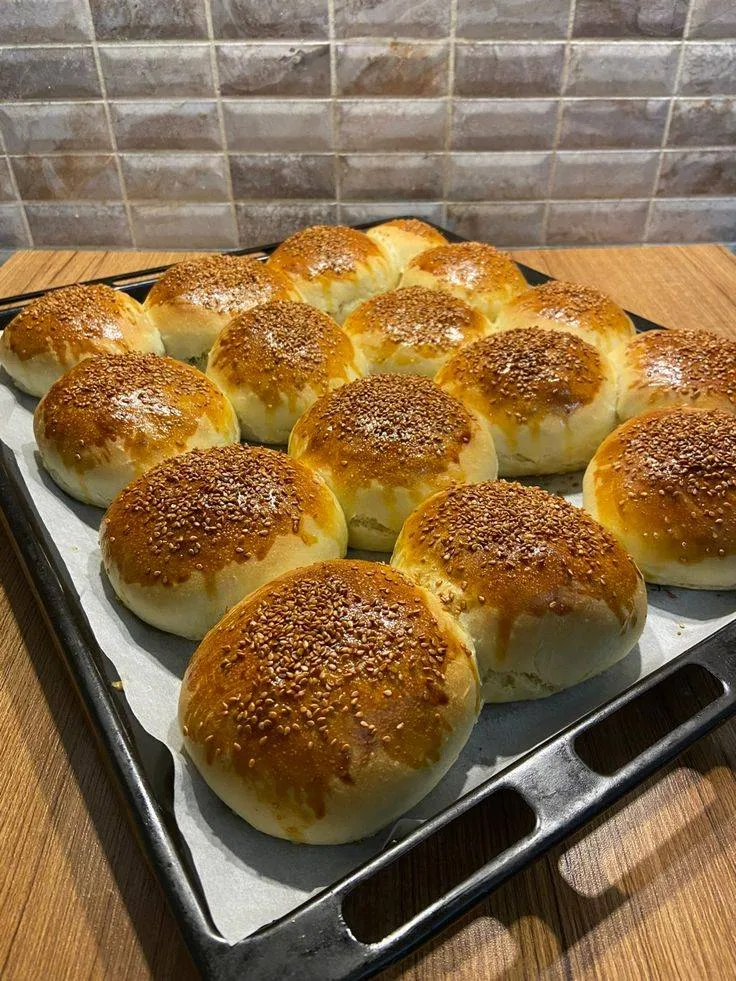 Pin it
Pin it
This homemade hamburger bun recipe transforms your burger experience with soft, buttery buns that put store-bought versions to shame. These golden, pillowy buns have the perfect texture—sturdy enough to hold juicy burgers without becoming soggy, yet tender enough to complement rather than overwhelm your fillings.
I first made these buns for a summer barbecue when the local store ran out of hamburger rolls. My guests couldn't stop raving about them, and now I'm permanently on bun duty for family gatherings—a task I happily accept.
Ingredients
- Active dry yeast: Ensures proper rise and that signature yeasty flavor. Fresh yeast works too if available.
- Warm water and milk: Combination creates the perfect moisture balance for soft texture.
- Sugar: Feeds the yeast and adds subtle sweetness that complements savory fillings beautifully.
- All-purpose flour: Works perfectly here no need for specialty flours unless you want to experiment.
- Unsalted butter: Enriches the dough giving these buns their melt-in-your-mouth quality.
- Egg: Adds richness to the dough while a separate egg wash creates that bakery-style golden top.
- Sesame or poppy seeds: Optional but they add professional-looking finish and subtle flavor.
Step-by-Step Instructions
- Activate the Yeast:
- Combine warm water, milk, yeast, and sugar in a large bowl, stirring gently to dissolve. Let this mixture sit undisturbed for 5 to 10 minutes until it becomes foamy and fragrant. The mixture should look creamy and active if your yeast is healthy.
- Create the Dough Base:
- Add the egg, flour, and salt to your foamy yeast mixture. Mix everything together until a rough shaggy dough forms, then incorporate the softened butter. The butter should be room temperature soft but not melted for best incorporation.
- Develop the Gluten:
- Knead the dough either by hand on a lightly floured surface or with a mixer fitted with a dough hook for 8 to 10 minutes. The dough should become smooth, elastic, and slightly tacky but not sticky. Add flour tablespoon by tablespoon if needed, but resist adding too much as it can make buns dry.
- First Rise:
- Transfer your kneaded dough to a lightly oiled bowl, turning once to coat all sides. Cover with a damp kitchen towel or plastic wrap and place in a warm, draft-free location. Let rise for 1 to 2 hours until doubled in size. The dough should look puffy and spring back slowly when poked.
- Shape the Buns:
- Gently punch down the risen dough to release air bubbles. Divide into 8 equal portions using a bench scraper or knife. Roll each piece into a smooth ball by cupping your hand over the dough and rotating in circular motions against your work surface. Place on a parchment-lined baking sheet, leaving room for expansion.
- Second Rise:
- Cover the shaped buns loosely with a clean kitchen towel and allow to rise again for 30 to 45 minutes. They should become noticeably puffy but not quite doubled. This second rise develops flavor and ensures proper texture.
- Prepare for Baking:
- Preheat your oven to 375°F while the buns complete their second rise. Mix egg yolk with milk to create an egg wash, then gently brush over the tops of the buns. Sprinkle with sesame or poppy seeds if using.
- Bake to Golden Perfection:
- Bake in the preheated oven for 15 to 18 minutes until the tops are beautifully golden brown. The buns should sound hollow when tapped on the bottom. Transfer to a wire rack immediately to prevent soggy bottoms and allow to cool completely.
 Pin it
Pin it
Making Ahead and Storage
These hamburger buns stay fresh at room temperature in an airtight container for up to three days. For longer storage, freeze completely cooled buns in a freezer-safe bag for up to two months. Thaw at room temperature or pop frozen buns directly into a 350°F oven for about 5 minutes to refresh.
Customization Options
The basic dough serves as an excellent canvas for variations. Try adding 1 tablespoon of herbs like rosemary or thyme for savory burgers. For sweeter applications, increase sugar to 3 tablespoons and add 1 teaspoon cinnamon. You can also substitute up to half the all-purpose flour with whole wheat flour for a heartier bun, though you may need to add an extra tablespoon of liquid.
Troubleshooting Common Issues
If your dough seems too sticky during kneading, resist adding too much additional flour which can make the buns dense. Instead, lightly oil your hands or let the dough rest covered for 10 minutes to allow the flour to fully hydrate. For dough that won't rise properly, ensure your yeast is fresh and that your rising environment is warm enough—ideally between 75°F and 80°F.
Frequently Asked Questions
- → How do I make the buns soft and fluffy?
Knead the dough thoroughly for 8–10 minutes to develop gluten, and allow enough time for both rises to ensure a light texture.
- → Can I use instant yeast instead of active dry yeast?
Yes, but reduce the amount slightly and skip the activation step, mixing it directly with the dry ingredients.
- → What toppings can I use for the buns?
You can sprinkle sesame seeds, poppy seeds, or leave them plain. Be sure to brush with egg wash for a shiny finish.
- → How should I store the buns?
Store the buns in an airtight container at room temperature for up to 3 days or freeze for up to 2 months.
- → Can I make smaller or larger buns?
Yes, simply divide the dough into the desired portion sizes and adjust the baking time as needed.
